
| Animalia | Passeriformes | Corvidae | Corvus | Corvus crassirostris |
The thick-billed raven (Corvus crassirostris) stands out as one of the most remarkable members of the corvid family, known for its impressive size and distinctive bill. Among the many types of birds native to the Horn of Africa, this species is renowned for its physical attributes, intelligence, and adaptability.
The thick-billed raven is often found in highland regions, occupying various habitats ranging from open country to agricultural areas and even urban environments. Its presence is notable in remote mountain landscapes and in proximity to human settlements, reflecting its resourcefulness in exploiting different ecological niches.
Table of Contents
- Common Name: Thick-billed raven.
- Family: Corvidae
- Body Dimensions: 60-64 cm in length, 1.15 to 1.5 kg in weight.
- Male Plumage Colors: Glossy black, oily brown, white nape.
- Female Plumage Colors: Glossy black, oily brown, white nape.
- Habitat: Mountains, high plateaux, urban areas.
- Diet: Omnivorous; grubs, carrion, seeds, wheat.
- Native Countries: Ethiopia, Eritrea, Somalia.
- Continent: Africa
Thick-billed Raven Characteristics

The thick-billed raven is the largest type and one of the largest passerine birds in the world, with adults reaching lengths of 60 to 64 cm.
- Its most distinctive feature is the massive, laterally compressed bill, from which the species gets its name.
- The upper mandible is adorned with a prominent white patch at the base, a characteristic unique among ravens.
- This bill is a visual hallmark and a functional adaptation, aiding the bird in cracking open tough food items.
Plumage is predominantly black with a purplish sheen, especially noticeable in good light.
- Unlike certain types of black birds, its nape and sides of the neck display a contrasting white patch, which is particularly conspicuous in adults and gives the bird a striking appearance.
- The throat feathers are elongated and shaggy, forming a distinctive beard. The wings are broad and rounded, and the tail is wedge-shaped, typical of ravens.
Sexes are similar in appearance, with no significant sexual dimorphism reported.
- Juveniles resemble adults but may have duller plumage and less pronounced white markings.
- The legs and feet are strong and black, well-suited for walking and perching.
The thick-billed raven’s robust build, unique bill structure, and striking coloration make it easily distinguishable from other corvids in its range.
![]()
Thick-billed Raven Habitat
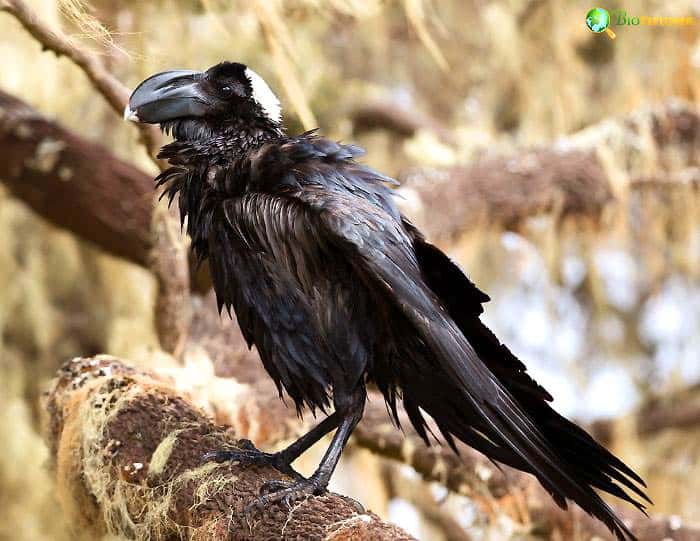
The thick-billed raven can be found in the Horn of Africa, with its range mainly confined to the highlands of Ethiopia and Eritrea (though it can also be seen in Somalia).
- It is most commonly found at elevations between 1,200 and 4,100 meters above sea level, favoring montane and submontane regions.
- Typical habitats include rocky outcrops, cliffs, gorges, open moorlands, and cultivated fields.
- The species can also be observed in villages, towns, and cities.
This raven is particularly associated with the Ethiopian plateau, where it exploits a variety of environments, from remote wilderness areas to agricultural landscapes.
- Its ability to thrive in natural and modified habitats highlights its ecological versatility.
- While it prefers open country with scattered trees or rocky terrain, it is not strictly limited to any single habitat type within its range.
![]()
Diet and Hunting Behavior
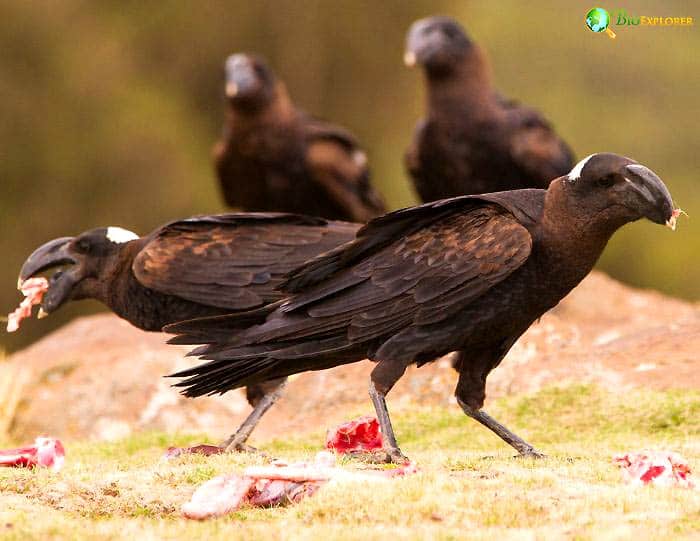
The thick-billed raven is an omnivorous and opportunistic feeder, displaying a varied diet.
- It consumes many food items, including carrion, insects, small mammals, birds, eggs, seeds, grains, and fruits.
- The powerful bill allows the raven to tackle tough food sources, such as breaking bones to access marrow or prying into hard-shelled seeds.
Scavenging is a significant component of its feeding behavior, with the species often seen foraging at rubbish dumps, abattoirs, and around human settlements for discarded food.
- It has also been observed feeding on animal carcasses in the wild, sometimes in the company of other scavengers.
- In agricultural areas, the thick-billed raven may feed on crops, particularly grains and legumes, occasionally conflicting with farmers.
The bird’s intelligence is evident in its foraging strategies, which include caching food for later consumption and using its bill to manipulate objects or uncover hidden prey.
- It is known to hunt small animals and raid nests for eggs and nestlings, demonstrating predatory and opportunistic tendencies.
- Social foraging is common, with pairs or small groups often seen feeding together, especially in areas with abundant food resources.
![]()
Breeding Behavior
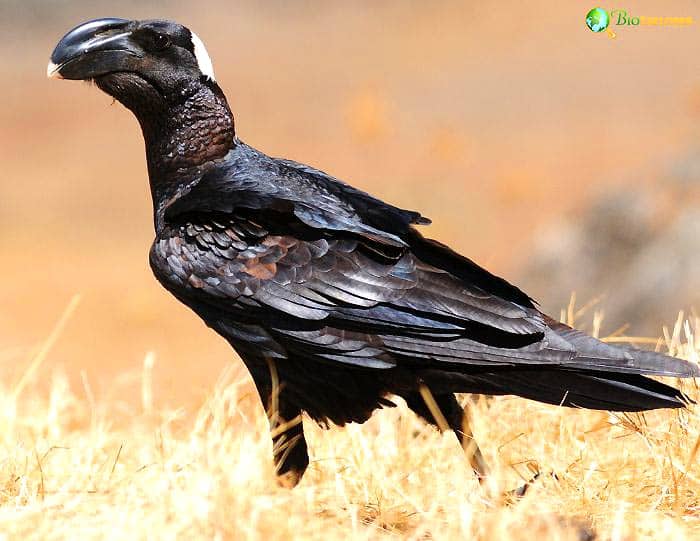
The thick-billed raven typically nests on cliffs, rocky ledges, or tall trees, often selecting sites that offer protection from predators and a wide vantage point over the surrounding landscape.
- Nests are large, bulky structures constructed from sticks and lined with softer materials such as hair, wool, or grass.
- Breeding pairs are believed to be monogamousWhat is monogamous?In biology, monogamous refers to a mating system in which an individual has an exclusive reproductive partnership with a single mate during a breeding season or for life., maintaining long-term bonds and defending their nesting territory vigorously.
- Both members participate in nest building and care for the young, with the female primarily responsible for incubation while the male provides food.
Clutch size is usually 3 to 5 eggs, pale greenish or bluish, with darker blotches.
- Incubation lasts approximately 20 days, after which the chicks hatch and are cared for by both parents.
- The young remain in the nest for several weeks before fledging, during which time the adults feed a varied diet.
- Family groups may remain together for some time after fledging, with juveniles learning essential survival skills from their parents.
- The choice of secure, elevated nesting sites and cooperative breeding behavior contributes to the species’ reproductive success in its environment.
![]()
Interactions with Other Wildlife
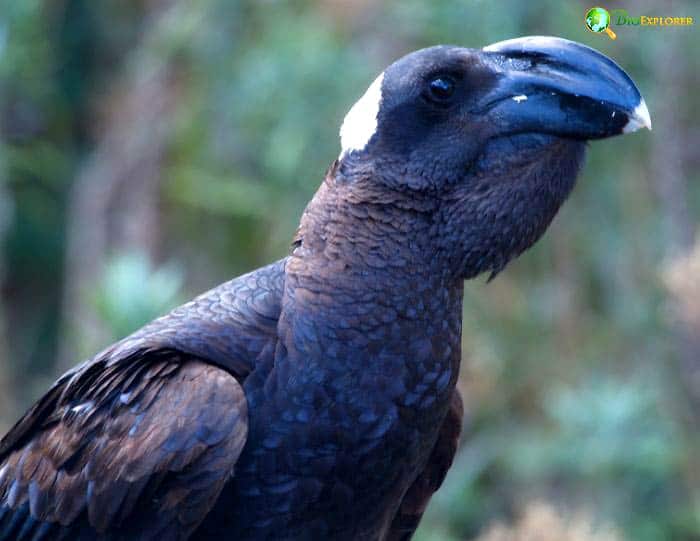
The thick-billed raven interacts with other species within its ecosystem, primarily as a scavenger and occasional predator.
- Its presence at carcasses often brings it into contact with other scavenging birds and mammals, leading to competitive and opportunistic feeding situations.
- The raven’s intelligence and assertiveness generally allow it to secure a share of available resources, even with larger competitors.
- Additionally, the thick-billed raven may raid the nests of other birds for eggs and nestlings, impacting local avian populations.
- It sometimes conflicts with humans and domesticated animals in agriculture due to its foraging habits.
Despite these interactions, these birds of Africa play an important role in nutrient cycling and ecosystem health through its scavenging activities.
![]()
Ecological Importance of Thick-billed Ravens
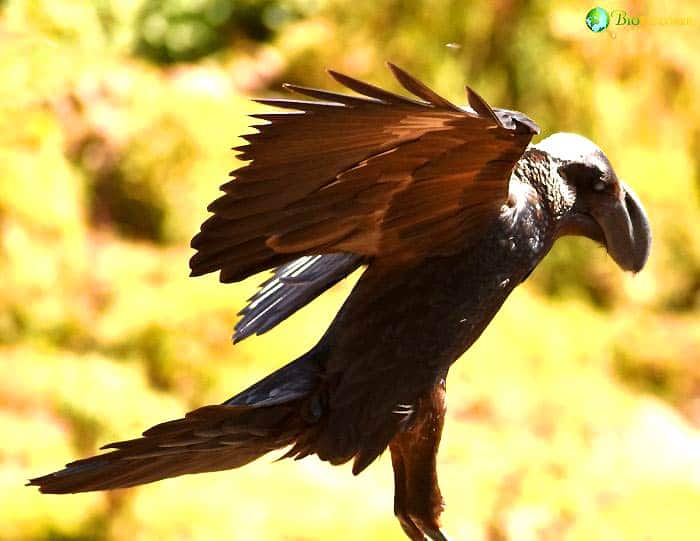
The thick-billed raven is currently listed as Least Concern by the IUCN, with a stable population trend and no major widespread threats identified at present.
- Within the Ethiopian, Eritrean, and Somali highlands, it is considered common and adaptable to various habitats, including those modified by human activity.
- Conservation measures for the thick-billed raven are minimal due to its secure status. However, ongoing habitat conversion, agricultural expansion, and potential persecution in some areas could pose localized threats in the future.
The thick-billed raven plays a vital ecological role as both a scavenger and a predator, helping to control populations of pests and clean up carrion, thus contributing to ecosystem health. Its presence is also culturally significant in some regions, where it is recognized as a distinctive and charismatic component of the highland avifauna.
![]()
Thick-billed Raven Fun Facts
- The thick-billed raven is the largest raven species in the world, surpassing even the common raven in size.
- The white patch at the base of its bill is unique among ravens, giving the bird a striking appearance.
- This species is highly intelligent and has been observed using tools to solve complex problems in captivity and the wild.
- Thick-billed ravens are known for their varied and sometimes musical vocalizations, which include croaks, clicks, and whistles.
- The thick-billed raven is known as a generalist species due to its varied diet; it can exploit almost any available food resource.
![]()
Frequently Asked Questions
Yes, they are often seen in pairs or small groups, especially when foraging. Their social nature is also evident in cooperative breeding behaviors and group interactions at food sources.
Do thick-billed ravens migrate?
No, the thick-billed raven is a resident species within its range and does not undertake long-distance migrations. It remains in the highlands of Ethiopia and Eritrea year-round.
How does the thick-billed raven differ from the White-necked Raven?
Although similar, the thick-billed raven is larger and has a much stouter bill with a prominent white patch at its base, distinguishing it from the white-necked raven.
Can the thick-billed raven adapt to urban environments?
Yes, this species has shown adaptability by foraging and nesting in towns and cities and remote mountain areas.
The thick-billed raven is a remarkable and distinctive bird, emblematic of the Ethiopian and Eritrean highlands.
Its impressive size, unique bill, and striking plumage make it a standout among corvids, while its intelligence and adaptability ensure its continued success across many habitats.
![]()











